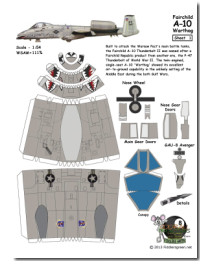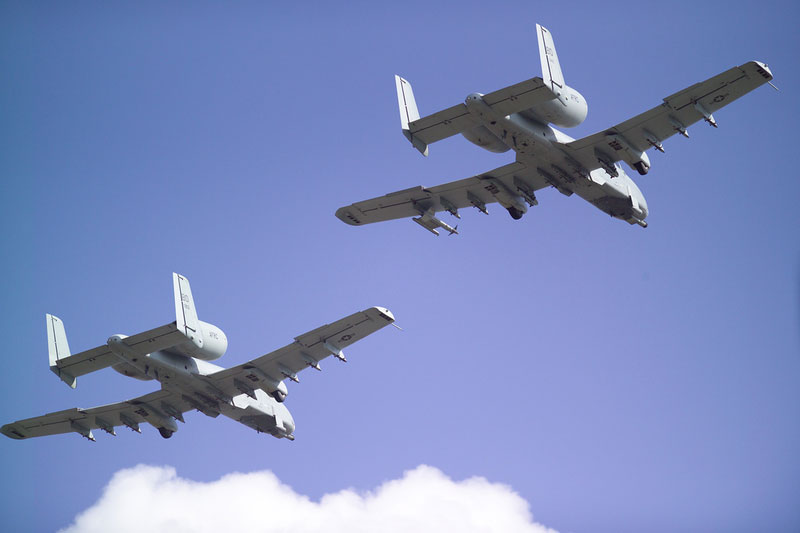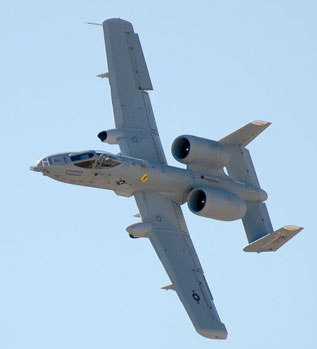



Fairchild-Republic-A10 - $$7.00
The A-10 Thunderbolt II is an American single-seat, twin-engine, straight-wing jet aircraft developed by Fairchild-Republic for the United States Air Force to provide close air support (CAS) of ground forces by attacking tanks, armored vehicles, and other ground targets with a limited air interdiction capability. It is the first U.S. Air Force aircraft designed exclusively for close air support. MODEL NOW AVAILABLE. (7 sheets plus assembly diagram page)
Fairchild-Republic A-10 Thunderbolt II "The Warthog"

Built to attack the Warsaw Pact's main battle tanks, the Fairchild A-10 Thunderbolt II was named after a Fairchild Republic product from another era, the P-47 Thunderbolt of World War II. The twin-engined, single-seat A-10 'Warthog' showed its excellent air-to-ground capability in the unlikely setting of the Middle East during the first and second Gulf Wars, despite a proposed change of role for the A-10 in line with changes in USAF policy.

Fairchild-Republic's A-10 Thunderbolt II "Warthog"
 The second outstanding attack aircraft of the 80s is the Fairchild A-10, known to its pilots as the 'Warthog', a twin-engined single-seater with an insatiable appetite for enemy tanks. The whole aircraft is built around the massive, seven-barrelled, 30 mm rotary gun which can split a tank or similar armored vehicle into pieces with a single momentary burst. Four underwing pylons can take a total weapons load of 16,000 lb. A-10s are usually painted overall matt green with yellow blotches for camouflage at low altitudes. They carry the very latest in ECM equipment in self-contained pods.
The second outstanding attack aircraft of the 80s is the Fairchild A-10, known to its pilots as the 'Warthog', a twin-engined single-seater with an insatiable appetite for enemy tanks. The whole aircraft is built around the massive, seven-barrelled, 30 mm rotary gun which can split a tank or similar armored vehicle into pieces with a single momentary burst. Four underwing pylons can take a total weapons load of 16,000 lb. A-10s are usually painted overall matt green with yellow blotches for camouflage at low altitudes. They carry the very latest in ECM equipment in self-contained pods.
Since the Second World War ground attack weapons have improved dramatically. The basic principle of making an armored thrust with air support may not have changed, but reaction times are faster and weapons can be delivered with frightening accuracy.
Notable among the new munitions are certain types of napalm, the retarded bomb and the cluster bomb unit (CBU). Napalm is a thickened petroleum jelly which clings to the target when it burns. It also burns up the oxygen in the area which means that it is effective against bunkers and armored vehicles. The retarded bomb has fins which reduce its speed on release so that the parent aircraft is safely beyond the target by the time it explodes. This allows fighter-bombers to drop at lower and consequently more accurate heights.
The CBU is particularly effective against 'soft' targets or men in the open. It consists of an outer bomb casing which contains 'bomblets', usually filled with metal fragments. The CBU is dropped by the attacking aircraft at low level and explodes above the ground, scattering the 'bomblets' over a wide area. They either explode on contact or remain in the ground as an anti-personnel minefield.
And unusual, highly-specialized bomb is the 'dibber', which is designed to destroy airfields. After release from the parent aircraft it is slowed down by u parachute and then fired downwards by tiny rockets to penetrate the surface of an airfield. Once into the ground it explodes, creating a massive crater that prevents any enemy aircraft from using that part of the airfield until a great deal of time-consuming repair work has been carried out.
The need for a close air support (CAS)/anti-armor was one of the lessons learned in the Vietnam conflict. The machine needed to be able to fly from rough forward airstrips, cary heavy weapon loads and withstand battle damage. Speed was not a major consideration.

Fairchild's A-10A was the design chosen to fill the 'A-X' requirement. A sturdy, somewhat heavy, single-seat attack aircraft, the A-10 was said to be too slow; it flew at subsonic speeds in an era when fast anti-aircraft missiles were rapidly appearing on the scene.
Despite this, 713 A-10s were built, and the first entered service in 1976. Units in the continental US, Alaska, Europe and Korea were equipped with the type. However, the end of the Cold War meant that this specialist aircraft was no longer a vital requirement, and it was to be replaced by the Lockheed Martin F-16.
Surplus A-10s began to take over from the well-worn Rockwell OV-10 Broncos in the forward air control (FAC) role, with a number being re designated OA-10A without undergoing any modifications, apart from changes to cockpit lighting to make them compatible with NVG equipment.
More than 100 A-10s were committed to the 1991 Gulf War and performed admirably in the air-to-ground and FAC roles.

A-10 Thunderbolt II

The A-10 Thunderbolt II is an American single-seat, twin-engine, straight-wing jet aircraft developed by Fairchild-Republic for the United States Air Force to provide close air support (CAS) of ground forces by attacking tanks, armored vehicles, and other ground targets with a limited air interdiction capability. It is the first U.S. Air Force aircraft designed exclusively for close air support.
The A-10's official name comes from the Republic P-47 Thunderbolt of World War II, a fighter that was particularly effective at close air support. The A-10 is more commonly known by its nickname "Warthog" or simply "Hog". As a secondary mission, it provides airborne forward air control, guiding other aircraft against ground targets. The A-10 is expected to be replaced by the F-35 in 2028 or later. A-10s used primarily in this role are designated OA-10.
Background
Criticism that the U.S. Air Force did not take close air support seriously prompted a few service members to seek a specialized attack aircraft. In the Vietnam War, large numbers of ground-attack aircraft were shot down by small arms, surface-to-air missiles, and low-level anti-aircraft gunfire, prompting the development of an aircraft better able to survive such weapons. In addition, the UH-1 Iroquois and AH-1 Cobra helicopters of the day, which USAF commanders had  said should handle close air support, were ill-suited for use against armor, carrying only anti-personnel machine guns and unguided rockets meant for soft targets. The F-4 Phantom II was pressed into close air support, but usually in emergencies, as its high cruising speed and fuel consumption hindered its ability to loiter. The lack of a gun on most F-4 variants, coupled with the relative ineffectiveness of the standard 20 mm round on M61 Vulcan-equipped F-4Es against hard targets, made strafing runs either impossible or ineffective.
said should handle close air support, were ill-suited for use against armor, carrying only anti-personnel machine guns and unguided rockets meant for soft targets. The F-4 Phantom II was pressed into close air support, but usually in emergencies, as its high cruising speed and fuel consumption hindered its ability to loiter. The lack of a gun on most F-4 variants, coupled with the relative ineffectiveness of the standard 20 mm round on M61 Vulcan-equipped F-4Es against hard targets, made strafing runs either impossible or ineffective.
A-X
On 6 March 1967, the U.S. Air Force released a Request for Information to 21 defense contractors. Their objective was to create a design study for a low-cost attack aircraft designated A-X, or "Attack Experimental". The officer in charge of the project was Colonel Avery Kay.In 1969, the Secretary of the Air Force asked Pierre Sprey to write the detailed specifications for the proposed A-X project. However, his initial involvement was kept secret due to Sprey's earlier controversial involvement in the F-X project. Sprey's discussions with A-1 Skyraider pilots operating in Vietnam and analysis of the effectiveness of current aircraft used in the role indicated the ideal aircraft should have long loiter time, low-speed maneuverability, massive cannon firepower, and extreme survivability;an aircraft that had the best elements of the Ilyushin Il-2, Henschel Hs 129 and A-1 Skyraider. The specifications also demanded that the aircraft cost less than $3 million. In May 1970, the USAF issued a modified, and much more detailed request for proposals, as the threat of Soviet armored  forces and all-weather attack operations became more serious. Now included in the requirements was that the final aircraft would be designed specifically for the GAU-8 Avenger.Six companies submitted proposals to the USAF, with Northrop and Fairchild Republic selected to build prototypes: the YA-9A and YA-10A, respectively.
forces and all-weather attack operations became more serious. Now included in the requirements was that the final aircraft would be designed specifically for the GAU-8 Avenger.Six companies submitted proposals to the USAF, with Northrop and Fairchild Republic selected to build prototypes: the YA-9A and YA-10A, respectively.
The YA-10A first flew on 10 May 1972. After trials and a fly-off against the YA-9A, the Air Force selected Fairchild-Republic's YA-10A on 10 January 1973 for production. There was an additional fly-off against the Ling-Temco-Vought A-7D Corsair II, the principal Air Force attack aircraft at the time, in order to prove the need to purchase a new attack aircraft. The first production A-10 flew in October 1975, and deliveries to the Air Force commenced in March 1976 to units at Davis-Monthan Air Force Base, Arizona. The first squadron to use the A-10 went operational in October 1977. In total, 715 airplanes were produced, the last delivered in 1984.
One experimental two-seat A-10 Night Adverse Weather (N/AW) version was built by converting an A-10A. The Night Adverse Weather (N/AW) aircraft was developed by Fairchild from the first Demonstration Testing and Evaluation (DT&E) A-10 for consideration by the USAF. It included a second seat for a weapons system officer responsible for ECM, navigation and target acquisition. The variant was canceled and the only two-seat A-10 built now sits at Edwards Air Force Base awaiting a spot in the Flight Test Historical Foundation museum. The proposed two-seat A-10 trainer aircraft did not go into production, as it was felt that the A-10 was simple enough to fly that a trainer version would not be required.
The decision to make the 30 mm GAU-8 gun the main anti-tank weapon of the A-X was influenced by Vietnam era A-1 pilots and by Hans-Ulrich Rudel and his book, "Trotzdem" (Released in the U.S. as a substantially edited version under the name "Stuka Pilot"). In World War II, Rudel flew the Ju 87G Stuka for the Luftwaffe and destroyed many Soviet tanks using its two underwing Bordkanone BK 3.7 37 mm caliber anti-tank auto cannon. His book was required reading for members on the A-X project. The Ju 87G was an outmoded airframe with improvised anti-tank weapons attached, yet still inflicted significant casualties on Soviet tank forces.

Specifications
 |
Length: 53 ft 4 in
|
 |
 |
 |
 |
 |
Pictured here is the GAU-8/A Avenger gatling cannon that is mounted on the front of an A-10. |
 |
|||
| A:Two General Electric TF34 turbofans power the A-10 and are high-mounted in pods to the rear of the aircraft to avoid debris when using rough airstrips. | B: In its original 'tank-busting' role the A-10's main weapon was the General Electric GAU-8/A Avenger 30-mm seven-barrelled Gatling-type Cannon. | C: For the FAC role the OA-10 carries few weapons apart from two rocket pods for target marking and AIM-9 Sidewinder air-to-air missiles. | D:The main undercarriage retracts forwards into an underwing bay. In theory, once the aircraft's weapon load has been dropped, a safe wheels up landing can be made with minimal wing damage. |
US New A-10 Warthog After Upgrade SHOCKED The World! (12:37 minutes long)
|
|

|
Aaron Murphy's Republic Faichild A-10 Warthog Paper Model

|

|

|

|

|
At this scale I opted out of the armament!!! Besides I'm more interested in the Aircraft. |



